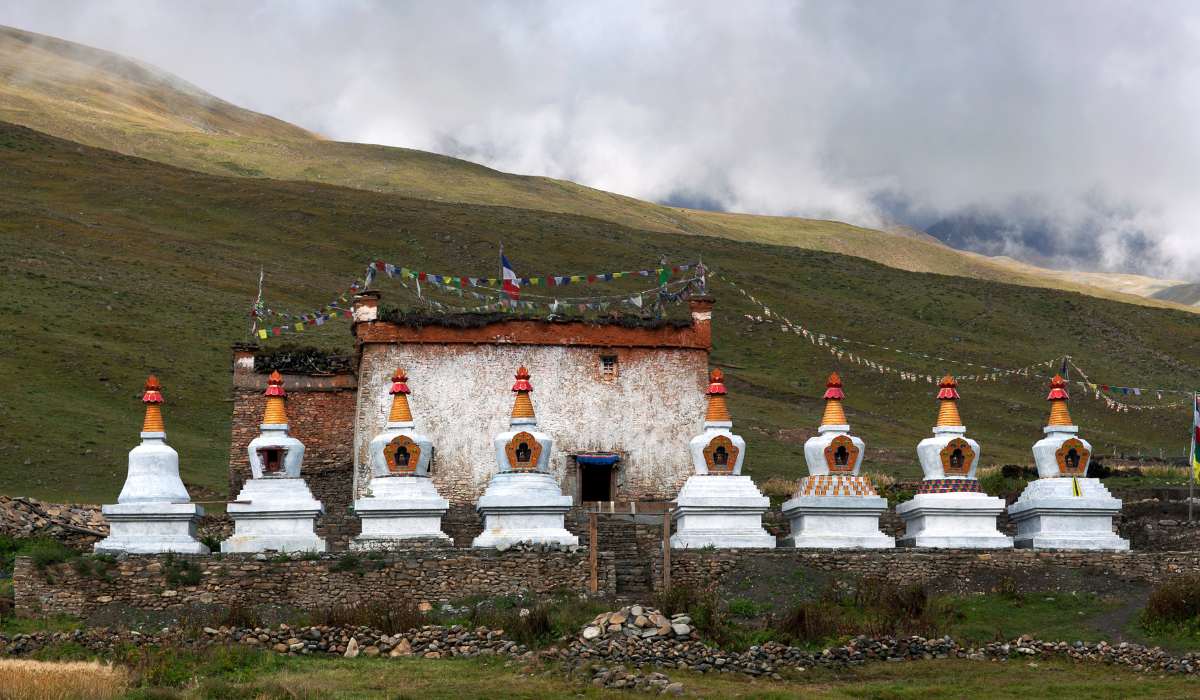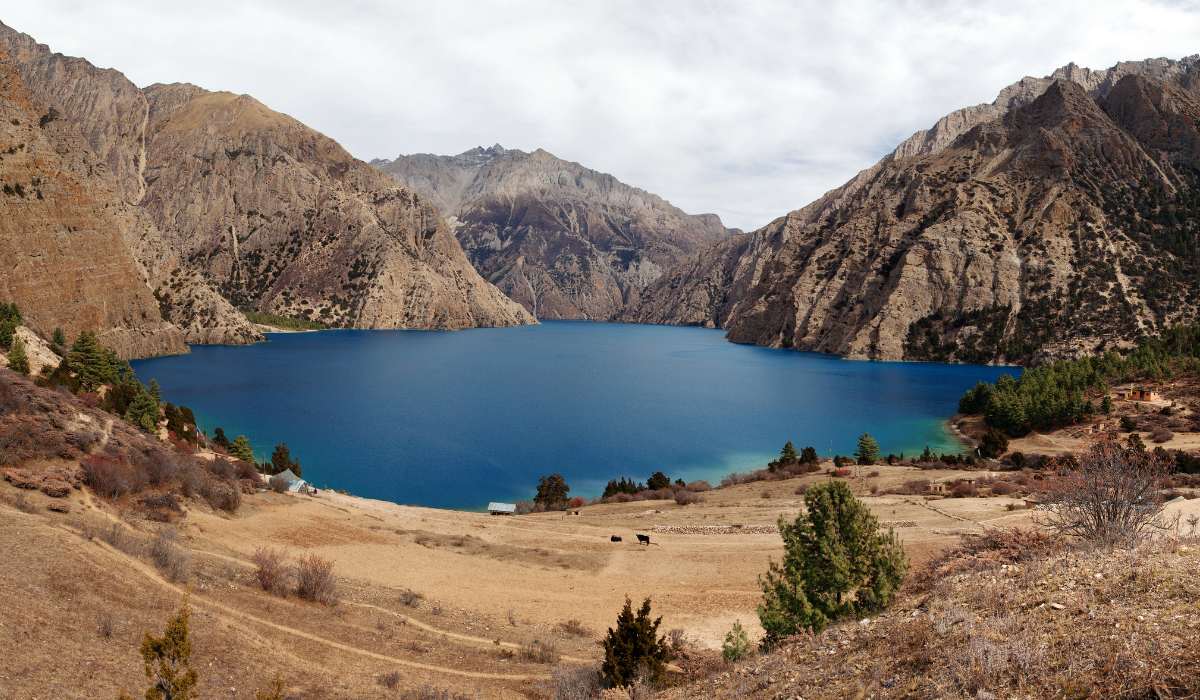
Dho Tarap Dolpo

Dho Tarap Dolpo
swotah travel
2093
07, 02 2023
Would you like to immerse yourself in a world characterised by picturesque landscapes, rich cultural heritage, and stunning scenic views? If so, we invite you to venture to Dho Tarap Dolpo, where the natural beauty of the mountains and rivers comes alive.
Access to the hidden gem of Dolpo and a journey to Dho-Tarap can be achieved within a day's travel from nine captivating villages. The path to the east leading to the Charka village and the Mustang district is available for selection. Heading south will bring you to the calm Sahartara and the energetic Kathmandu. The western terrain presents two distinctive routes for the adventurous traveller. The first trail sets out to Phoksundo, Nepal's deepest lake, and proceeds toward the Jumla district.
The second trail embarks towards the revered Shey Gompa 4200m/ 13779 ft, which culminates in the Mugu district to the west. The mesmerising topography, serene waterways dotted with turquoise-hued lakes, quaint villages boasting spectacular architecture, revered monasteries and stupas, unique mani walls, and profound cultural traditions of Bon, Buddhism, and Amchi cause Dho-Tarap and Dolpo an unforgettable travel experience in Nepal.
Introduction to Dho Tarap Dolpo
Trekking in Nepal's Dolpo region is a great way to experience the grandeur of Nepal's rugged and remote far west, which borders Tibet and has a landscape reminiscent of its northern neighbour. This region is home to the Shey-Phoksundo National Park, Nepal's biggest national park. Although underdeveloped and relatively poor, intrepid trekkers are rewarded for their efforts with deep valleys, high passes, peaks, the turquoise Lake Phoksundo, the 800-year-old Shey Monastery, and some rare wildlife—including the elusive snow leopard.
Dho Tarap valley, located at the core of Dolpo, is constituted under the Dolpo Buddha Rural Municipality (DBRM) in north-western Nepal's Karnali Province's Dolpa District. The valley is inhabited by an estimated 1500 individuals residing in three distinct villages, specifically, Dho, located in DBRM ward 1, Tokyu within DBRM ward 3, and Lang in DBRM ward 1. Dho Tarap has transformed its former role as the administrative centre of Dolpo to its current status as the Dolpo Buddha Rural Municipality's headquarters and trade centre. It also holds a unique position as one of the highest human settlements in Nepal.
Accessing Western Nepal is more complex than other parts - most travellers fly to Nepalgunj from Kathmandu or Pokhara, then catch another flight to Juphal in the Dolpo district. Note that Juphal's small airstrip can be weather-delayed at times. Note that Juphal's small airstrip can be weather-delayed at times. Despite the ongoing road improvement projects in Western Nepal, accessing Juphal remains challenging, necessitating a several-day walk from the nearest road head.
Local Cultural Beliefs of Dho Tarap Dolpo
Dolpo, the largest among the 75 districts in Nepal, boasts a rich blend of Hindu and Buddhist influences. Hinduism heavily influences the southern Lower Dolpo region. At the same time, the Upper Dolpo is deeply soaked in Tibetan Buddhism and the ancient Bon tradition, reflecting its proximity to Tibet for centuries.
Ancient scrolls scooped in Dolpo forecast Lord Buddha's prophecy, where meditating in solitude could lead to enlightenment. Locals believe that Guru Rinpoche blessed the whole area when he visited centuries ago to suppress three demonesses from Tibet during the 8th century. The sacred caves and rock formations where he and other Lamas meditated are considered holy places for Buddhist pilgrims. Numerous monasteries can be found here, some dating back over 700 years.

Photo: Ancient monastery of Dho Tarap
In Dolpo, Nyingma, the distinguished Red Hat sect of Buddhism, holds prominence, focusing on the revered tales of Guru Rinpoche. Tibetan Buddhism presents a dual perspective in this region, encompassing the monastic community's devout religious practices and the general population's daily spiritual observances.
Dolpo is one of few places where Bon Religion still exists in its original form. Saying this, some Bonpo monasteries here are among the oldest around. Bon was widely practised before most Tibetans converted to Buddhism. For generations, the two religions lived side by side without influencing each other until Bon incorporated parts of both into its belief system.
What Is the Weather Like in Dho Tarap Dolpo?
Dho Tarap Dolpo is a high-altitude region of Nepal located in the Himalayas. The climate of the area is typically a cold, dry alpine climate. It is characterised by long, cold winters and short, cool summers. Dho Tarap Dolpo offers a unique opportunity to experience a wide range of weather conditions for a curious traveller who enjoys exploring and learning about new cultures and environments.
Summer
The idyllic summer months in the charming village of Dho Tarap Dolpo are meticulously marked from June to October, presenting an ideal period to explore its captivating landscapes. During this season, the climate remains moderate, with temperature fluctuations ranging from a warm 25°C (77°F) to a cool seven °C (44°F). While the likelihood of rain is low, the occasional shower or thunderstorm may be experienced.
Winter
The winter months in Dho Tarap Dolpo are generally from November to March. During this time, temperatures can range from an average high of 42°F (6°C) to an average low of 8°F (-13°C). Snowfall is common during winter, with an average annual snowfall of 16 inches (40 cm). When packing for a winter trip to Dho Tarap Dolpo, travellers should bring plenty of warm winter clothing and layers, a waterproof coat, and sturdy shoes or boots for potential hikes.
Spring
The spring months in Dho Tarap Dolpo are generally from April to May. During this time, temperatures range from an average high of 64°F (18°C) to an average low of 33°F (1°C). Rainfall is generally low during spring, with occasional showers and thunderstorms.
Fall
The autumn months in the charming region of Dho Tarap Dolpo are delightfully present from October to November. During this idyllic period, temperatures fluctuate between a pleasant average high of 73°F (23°C) and a nippy average low of 35°F (2°C). Rainfall is sparingly observed during autumn, with the occasional shower or thunderstorms adding a touch of drama to the landscape. When packing for a fall trip to Dho Tarap Dolpo, travellers should be sure to bring lightweight clothing that can be layered, rain gear, and sturdy shoes or boots for potential hikes.
Key Sights to Visit in Dho Tarap Dolpo
The must-see sights of Dho Tarap Dolpo include Shey Gompa, Chharka Chhetri, Numa La Pass, Phoksundo Lake, and Ringmo Village.
Shey Gompa is an ancient Tibetan Buddhist monastery located on a hilltop in the Shey Phoksundo National Park.
The Monastery is a home place for a considerable number of monks who devoutly follow the teachings of Tibetan Buddhism. It is also a sought-after tourist attraction due to its architectural beauty, characterised by elaborate wooden carvings and vibrant paintings adorning its walls.

Photo: Shey Phoksundo lake
Numa La Pass is a mountainous route situated between two peaks in the Himalayan range. The pass boasts breathtaking vistas of the neighbouring mountains and valleys and provides a serene environment for those seeking solitude. The pass can be accessed by embarking on a trek through the Shey Phoksundo National Park or opting for a jeep journey from Juphal. The Phoksundo Lake, situated in the Shey Phoksundo National Park, is a captivating body of water that boasts a remarkable turquoise color. The lake is surrounded by lush forests and rolling hills, making it a breathtaking sight. Visitors can take boat rides on the lake or take in the view from the shore.
The Ringmo Village is a quaint and traditional Tibetan settlement situated within the confines of the Shey Phoksundo National Park. It offers a unique opportunity for individuals to immerse themselves in the rich Tibetan culture and gain a deeper understanding of the lifestyle of the local inhabitants in this isolated region.
Dho Tarap is also rich in Buddhist culture and monasteries. According to the reports, there are more than 130 Gompas in Dho Tarap region, which reflects its pure leaning towards Buddhism. These monasteries boast a rich history and are home to various ancient artefacts and statues. Visitors can immerse themselves in Buddhism's history in the region and partake in traditional ceremonies held at the Monastery.
Also Read: Langtang Village: Before and After the Earthquake
Permits for Dho Tarap Dolpo Trek
The most important permit required for the Dho Tarap Dolpo trek is a Lower Dolpo Restricted Area Entry Permit. This permit is required for all trekkers, regardless of their route. The permit will cost anywhere between $30-50 USD per person and is valid for only 15 days from the day of issue.
In addition, trekkers also need Shey Phoksundo National Park Entry Permit - they are not required for Lower Dolpo trekking. Also, you will have to obtain Upper Dolpo Restricted Area Entry Permit.
These permits may cost $20 USD per person per week, and the Shey Phoksundo National Park Entrance Fee, which is priced at 3000 rupees per individual.
Obtaining Permits
The process of obtaining permits for the Dho Tarap Dolpo Trek can initially seem daunting, but it doesn't have to be.
-
Initiate your application procedure at least two weeks before your scheduled trek. This allows ample time for preparing and organizing necessary documents and paperwork to guarantee a smooth and seamless experience.
-
Start your application process at least two weeks in advance. This will give you plenty of time to ensure all your paperwork is in order before your trek begins.
-
Prepare your documents ready, like passport-sized photos, passport copies, and other necessary documents.
The Dho Tarap Dolpa region presents a rare fusion of stunning natural landscapes and rich cultural heritage, making it an impeccable choice for those who seek a blend of both. From Dho Tarap's stunning views to other areas such as Phoksundo with their attractions, there is something for everyone in Dolpa. The cultural and religious aspects of the region play a significant role in its history and must be considered while visiting it.
NEWSLETTER SIGNUP
Sign up to receive our trip ideas and travel offers!
Get updates and Exclusive Offers up to 20% Discount








